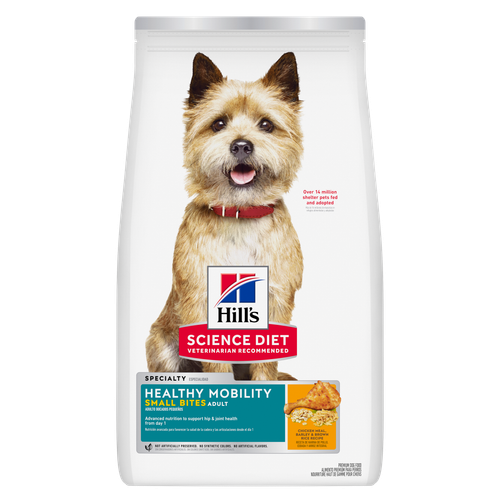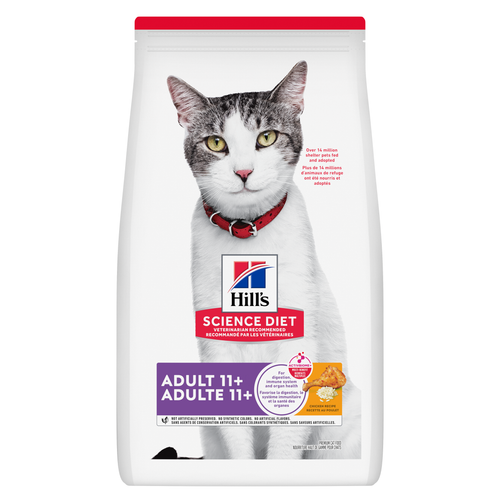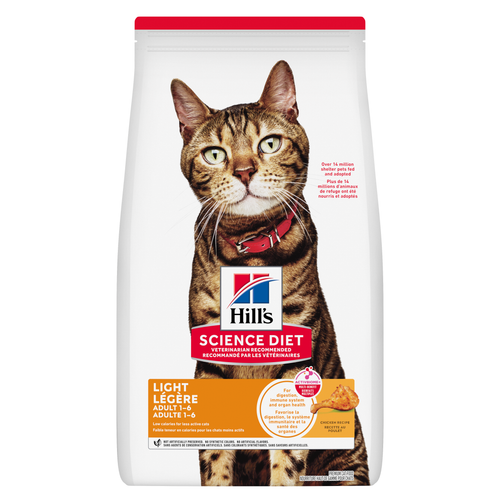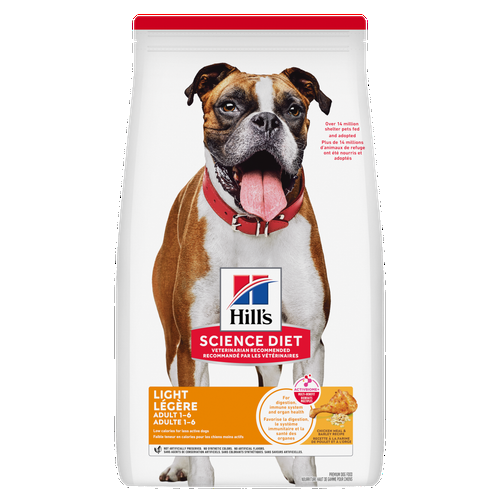
-
Find the right food for your petTake this quiz to see which food may be the best for your furry friend.Find the right food for your petTake this quiz to see which food may be the best for your furry friend.Featured products
 Adult Light Large Breed Chicken Meal & Barley Recipe Dog Food
Adult Light Large Breed Chicken Meal & Barley Recipe Dog Food18% lower calories vs. Science Diet Large Breed Adult
Shop Now Adult Sensitive Stomach & Skin Small & Mini Chicken Recipe Dog Food
Adult Sensitive Stomach & Skin Small & Mini Chicken Recipe Dog FoodHill's Science Diet Sensitive Stomach & Skin Small & Mini dry dog food is tailored nutrition for Small & Mini dogs while being gentle on stomachs. Nourishes skin & promotes a lustrous coat.
Shop Now Adult Healthy Mobility Small Bites Chicken Meal, Barley & Brown Rice Recipe Dog Food
Adult Healthy Mobility Small Bites Chicken Meal, Barley & Brown Rice Recipe Dog FoodAdvanced nutrition to support hip & joint health from day 1
Shop NowFeatured products Adult Healthy Cuisine Seared Tuna & Carrot Medley Cat Food
Adult Healthy Cuisine Seared Tuna & Carrot Medley Cat FoodDelicious seared tuna paired with tender carrots in a mouthwatering sauce
Shop Now Adult 11+ Chicken Recipe Cat Food
Adult 11+ Chicken Recipe Cat FoodSupports brain health & beautiful fur. Helps keep immune system, heart & kidneys healthy.
Shop Now Adult Light Chicken Recipe Cat Food
Adult Light Chicken Recipe Cat Food20% lower calories vs. Hill's Science Diet Adult
Shop Now -
Dog
- Dog Tips & Articles
-
Health Category
- Weight
- Food & Environmental Sensitivities
- Urinary
- Digestive
- Joint
- Kidney
- Dental
- Cancer
-
Life Stage
- Puppy Nutrition
- Adult Nutrition
- Senior Nutrition
Cat- Cat Tips & Articles
-
Health Category
- Weight
- Skin & Food Sensitivities
- Urinary
- Digestive
- Kidney
- Dental
- Stress
- Cancer
-
Life Stage
- Kitten Nutrition
- Adult Nutrition
Featured articles Antioxidants
AntioxidantsUnderstand the importance of antioxidants in your dog or cat's food, and how they can help protect your pet and keep them healthy.
Read More Importance of DHA in your Pet's Food
Importance of DHA in your Pet's FoodLearn about DHA, Docosahexaenoic Acid, a natural omega-3 fatty acid that is essential in the development of the brain and nervous system in cats & dogs.
Read More Water
WaterDiscover why water is the most important nutrient for your dog or cat to live a healthy life. Find out how much water your pet should consume each day.
Read More -


Is your dog losing hair on their tail? You might be curious if it is just falling out, a result of your dog chewing hair off their tail, or another larger health concern. Your dog's itchiness and red skin could be caused by an allergy, fleas, hormones, some kind of behavioral disorder, or in rare cases, a food allergy.
While the exact cause of a dog losing tail hair cannot be determined without the assistance of your veterinarian, there are clues to notice at home beforehand that can be valuable information for your vet.
Is Your Dog Chewing Hair Off Their Tail?
The most important thing to notice is whether your dog is chewing on their tail or not. A dog chewing hair off their tail will have rough, frizzy, and broken hair on the tail. The hair may also be wet with saliva. In addition, the skin on the tail will likely be red, inflamed and could have open sores from aggressive chewing.
If your dog is chewing, then it could be a flea allergy, especially during warmer months when fleas are more active. If your dog is allergic to fleas, just one bite can cause them to go crazy and chew their tail severely enough to create open sores. Flea allergy dermatitis is the number one cause of excessive tail chewing in dogs and may require flea treatment, antibiotics and/or steroids to stop the itching.

Other allergies can also result in tail chewing. A dog losing hair on their tail may be the result of a condition called atopy (environmental allergies) or food allergies. Dogs with these types of allergies may benefit from a therapeutic food and your veterinarian can provide this specific nutritional recommendation when needed.
Another reason a dog may be chewing their tail is because of anal gland issues. If you notice your dog licking and chewing their anus in conjunction with scooting, or if the anus looks swollen, then anal glands may be the problem. Treatment for anal gland issues could include anal gland expression, antibiotics, pain medication and possibly surgery if the anal gland is infected or abscessed. If your dog has repeated anal gland issues, your veterinarian may also recommend a therapeutic food.
Another (gross) cause of tail chewing could be intestinal worms. Tapeworms coming out of the anus can be irritating and cause your dog to lick and chew the anal area. The most common symptom of tapeworms is seeing rice-grain-like organisms adhered to your dog's bum. Tapeworms require fleas for their life cycle, and dogs who have fleas can have tapeworms as well — double gross! If you or your vet suspect intestinal parasites, then deworming medication is indicated, and if tapeworms are suspected, flea control is in order, as well.
In some cases, dogs can chew the hair off their tails in response to pain. Conditions such as arthritis in the tail, a broken tail, a foreign body like a foxtail stuck in the tail's skin, or lower back pain can all result in excessive tail grooming. Emotional distress from anxiety or fear and behavioral disorders, such as compulsive tail-chasing, can also cause excessive tail chewing. Each of these conditions requires different treatment, so talk with your vet. If your dog is chewing their tail due to behavioral reasons, your vet may recommend a certified dog behaviorist to discuss how to help your dog.


Tasty Tips
Is Your Dog's Tail Hair Falling Out?
If your dog isn't actively chewing and the tail is still going bald, then it may be time to look into other potential underlying causes. In dogs who are losing hair on the tail without chewing, any hair present on the tail appears smooth and not broken, and the skin is smooth, not red or inflamed.
Hormonal problems, such as hypothyroidism or Cushing's disease, can cause hair loss on the tail and sides of the abdomen. Dogs with an underactive thyroid often have weight issues and are lethargic. In addition to other clinical signs, dogs with Cushing's disease can have skin infections and hair loss.
If your vet suspects a hormonal problem, then your dog needs to be tested for hormonal imbalances. Your vet will likely recommend blood and urine testing and possibly an ultrasound. If your dog has a hormonal imbalance, then there are medications available to help. Hypothyroidism is typically treated with a thyroid supplement, and Cushing's can be treated with medication or surgery.
If your dog is chewing the hair off the tail or losing hair due to hormonal issues, then hair regrowth can be expected once they stop chewing the tail or the hormonal condition is controlled. Remember: according to the College of Veterinary Medicine at the University of Tennessee, hair grows in cycles, so regrowth will depend on where your dog is in the hair cycle. Therefore, patience is key!


Dr. Sarah Wooten graduated from UC Davis School of Veterinary Medicine in 2002. A member of the American Society of Veterinary Journalists, Dr. Wooten divides her professional time between small animal practice in Greeley, Colorado, public speaking on associate issues, leadership, and client communication, and writing. She enjoys camping with her family, skiing, SCUBA, and participating in triathlons.
Related products

Hill's Science Diet Sensitive Stomach & Skin Small & Mini dry dog food is tailored nutrition for Small & Mini dogs while being gentle on stomachs. Nourishes skin & promotes a lustrous coat.

18% lower calories vs. Science Diet Large Breed Adult

18% lower calories vs. Science Diet Adult

Advanced nutrition to support hip & joint health from day 1
Related articles

Your dog's coat and skin are a big part of your dog's overall health. Ensure you keep your dog's coat healthy, by following these simple tips.

Learn basic steps & precautions for treating a cut on your dog, including what you can put on the cut, and when you should take them to the vet.

Learn how dogs with sensitive skin can have special dietary needs, how they can develop over time in a healthy dog, and how Hill's dog food can help.

Discover how the field of dog science is giving us more and more insights into the inner workings of our furry best friends.

Put your dog on a diet without them knowing
Our low calorie formula helps you control your dog's weight. It's packed with high-quality protein for building lean muscles, and made with purposeful ingredients for a flavorful, nutritious meal. Clinically proven antioxidants, Vitamin C+E, help promote a healthy immune system.
Put your dog on a diet without them knowing
Our low calorie formula helps you control your dog's weight. It's packed with high-quality protein for building lean muscles, and made with purposeful ingredients for a flavorful, nutritious meal. Clinically proven antioxidants, Vitamin C+E, help promote a healthy immune system.

